Dumbbells and kettlebells are great for building total-body strength, but if you want to test how strong you really are, barbells are the way to go. Barbells allow you to lift heavier with more control since you’re holding the bar with both hands and recruiting several muscles at once. In fact, according to the American Council on Exercise, barbell movements are one of the best ways to target large muscle groups and help strengthen functional movement patterns.
That’s why we’re breaking down five of the most essential barbell exercises: the squat, deadlift, bench press, overhead press, and lunge. Master these moves, and you’ll not only get a great workout in — you’ll be able to set a three-rep max benchmark to continuously test your strength.
Note: Unless you’re a powerlifter, you can limit barbell training to just once a week. And if you can’t lift a barbell (typically 35 or 45 pounds), don’t worry. Keep at those dumbbell rows and kettlebell squats, and you’ll be stepping up to the bar in no time.
RELATED: 6 Mistakes You’re Making with a Barbell
Barbell Strength Test: How to Find Your 3RM
These barbell exercises are designed to test your three-rep maximum (3RM), which you can incorporate into your strength training routine. If it’s your first time working out with barbells, use the bar itself without any weights to do this five-set test on how to find your 3RM.
Set 1: For the bench press, overhead press, and deadlift, do one set with a weight you can lift for 5-10 easy reps. Rest one minute.
Set 2: Increase 5-10 pounds total for the bench press and overhead press, and 15-20 pounds total for the squat and deadlift. Do 6-8 reps for each exercise and then rest two minutes.
Set 3: Increase 5-10 pounds total for the bench press and overhead press, and 15-20 pounds total for the squat and deadlift. Do 4-6 reps, and then rest for two to four minutes.
Set 4: Increase 5-10 pounds total for the bench press and overhead press, and 15-20 pounds total for the squat and deadlift. Aim to do three reps.
Set 5: If you’re were able to do 3 reps, rest two to four minutes and then repeat the same exercise. If you completed a second round, you found your 3RM. But if you weren’t able to do 3 reps and only 1-2 reps, then you’ve found your 1RM or 2RM. Go back and adjust the weights so that you can find your three-rep maximum after doing 4-5 sets.
RELATED: The 5 Most Important Lifts to Master
5 Barbell Exercises to Build Total-Body Strength
Your goal: Complete one of these barbell exercises each week using your 3RM. To keep track of your progress, write down how much you can lift each week and gradually increase the weights by five percent once you’re able to do more than three reps.
1. Barbell Squat
Targets: Glutes, hamstrings, and quadriceps.
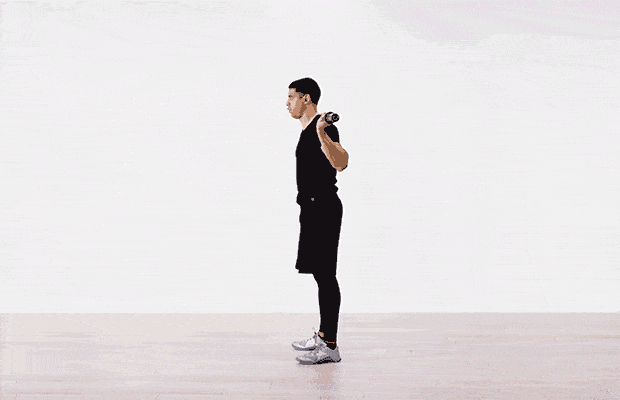
How to: Walk up to the barbell on the rack at shoulder height. Hold the barbell with your hands shoulder-width apart, thumbs over the top of it. Then, dip your head under the bar and position it on top of your back (a). Raise your elbows and chest to create a shelf to rest the bar along your shoulders and below the base of your neck (b). Keeping your chest and shoulders tight, remove the bar from the rack and take three steps back. Stand with your feet shoulder-width apart and slightly turned out, so your knees track over your feet (c). Take a deep breath and squat down, pushing your butt back, until your thighs are parallel to the ground (d). With control, stand back up without your knees turning in towards each other (e).
Safety first: Only do barbell squats where there is a power rack or squat stand to catch the bar, in case you can’t lift it back up.
RELATED: Are You Doing the Deadlift All Wrong?
2. Barbell Deadlift
Targets: Glutes, hamstrings, quadriceps, and latissimus dorsi.
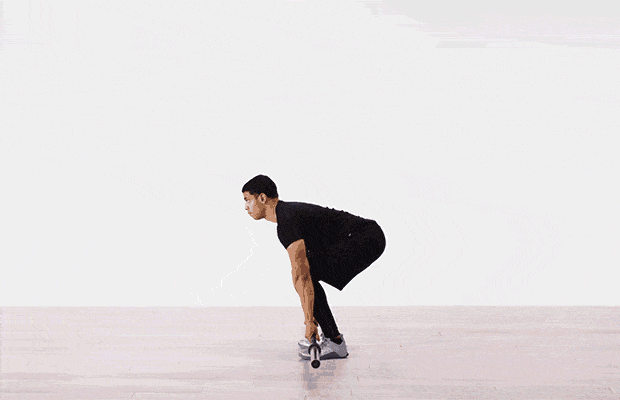
How to: Stand with your feet hip-distance apart and slightly turned out. Keep the bar one to one and a half inches from your shins, so it’s directly over your mid-foot (a). Grip the bar with your hands just outside of your legs with your arms straight. Bend your knees, lowering them until your shins touch the bar (b). Squeeze your chest and take a deep breath in. Keeping your back flat, drag the bar up your shins, slightly shifting your weight towards your heels (c). Continue to pull the barbell up until you’re standing with your shoulders back and chest is raised (d). Lower the bar back down, bending your hips and knees, while maintaining a flat back and keeping the bar close to your shins. Once it’s back on the ground, exhale and then let go of the bar.
Safety first: If you’re using just the 45-pound barbell, you may not be able to lower the barbell all the way to the ground since there aren’t weight plates to decrease the distance. Instead, lower the barbell until your back can no longer stay straight. Avoid bending over just to lower the empty bar.
3. Barbell Overhead Press
Targets: Deltoids, triceps, and trapezius.
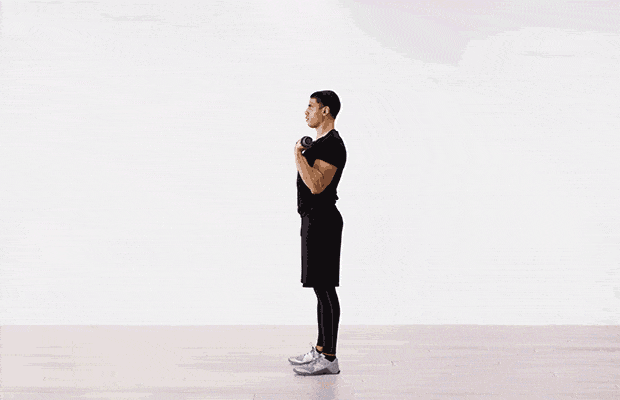
How to: Grip the barbell with your hands just outside of your shoulders. Place the bar in front of your shoulders with your back straight and firm, feet shoulder-width apart (a). Keeping your core tight, take a deep breath and press the bar straight up overhead until its directly above the back of your neck. The bar, your shoulder joint and your mid-foot should be in a straight line (b). When you’ve reached the top, shrug your shoulders up and lock your elbows completely out (c). Lower the bar back down to the front of your shoulders. Once the bar is touching or just above your shoulders, that’s one rep. (d).
Safety first: If a 45-pound barbell is too heavy to start, use a body bar or dumbbells instead.
RELATED: How to Find Your One-Rep Max
4. Barbell Bench Press
Targets: Pectoralis major, deltoids, and triceps.
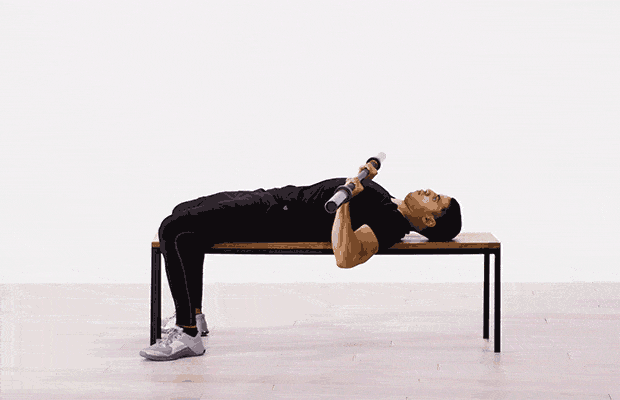
How to: Lie on your back on a bench and grasp the bar with your hands shoulder-width apart, feet flat on the ground. There should be a slight arch in your back, so there’s space between your lower back and the bench (a). Lower the bar to your chest, tucking your elbows in at 45 degrees by your sides (b). Once the bar touches your chest, drive your feet hard into the floor and, without pausing, press the bar back up (c).
Safety first: Be sure to do barbell bench presses in a bench press rack with a spotter. Keep your gaze up at the ceiling so the bar doesn’t move out of place.
RELATED: Olympic Lifts 101: How to Do the Barbell Snatch
5. Barbell Lunge
Targets: Glutes, hamstrings, quadriceps, hip flexors, and calves.
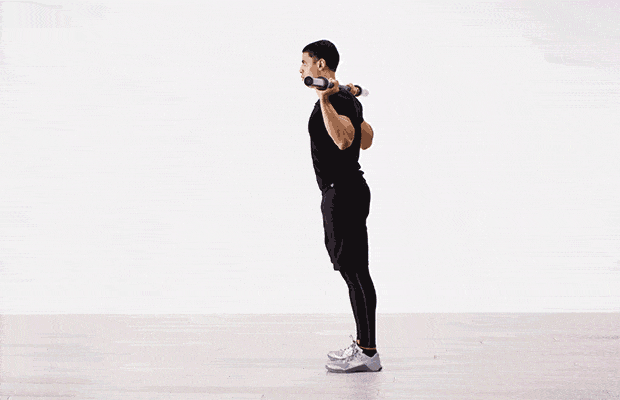
Although the barbell lunge isn’t part of the strength test, it helps build muscle endurance for the exercises above, especially the deadlift and squat. Beginners can do three sets of five reps, while advanced lifters can do four sets of 10 reps of forward and reverse lunges per leg.
How to: Place the barbell just beneath the base of your neck and along your shoulders. Stand with your feet hip-width apart, elbows raised and abs engaged (a). Take a big lunge forward with your right leg and lower until your left knee is one to two inches off the ground (b). Explode up and bring your right leg back to the starting position (c). Repeat the same movement with the left leg. This is one rep.
Read More
6 Weightlifting Exercises to Build Serious Strength
Strength Training for Beginners: Your Guide to Picking Weights
6 Strength Exercises to Go from Basic to Advanced
Not a Daily Burn member? Sign up at dailyburn.com and start your free 30-day trial today.
Originally posted on October 25, 2017. Updated on February 21, 2022
GIFs by Daily Burn. Cover image via Shutterstock
